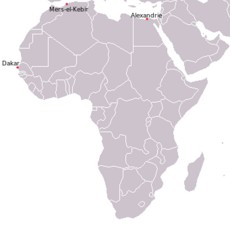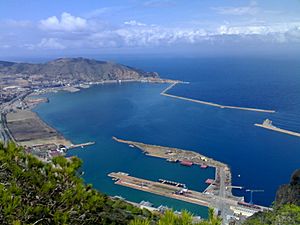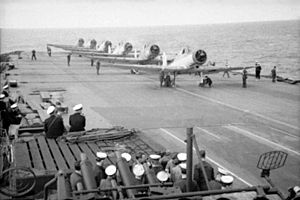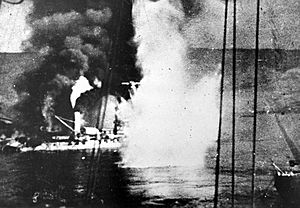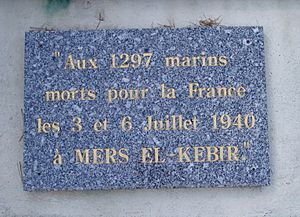Attack on Mers-el-Kébir facts for kids
Quick facts for kids Attack on Mers-el-Kébir |
|||||||
|---|---|---|---|---|---|---|---|
| Part of the Battle of the Mediterranean during the Second World War | |||||||
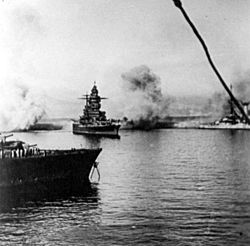 The battleship Strasbourg under fire |
|||||||
|
|||||||
| Belligerents | |||||||
| Commanders and leaders | |||||||
|
|||||||
| Strength | |||||||
|
|
||||||
| Casualties and losses | |||||||
|
|
||||||
The attack on Mers-el-Kébir was a surprise British naval attack. It happened on 3 July 1940, during the Second World War. British ships attacked French Navy ships at the naval base of Mers El Kébir. This base was near Oran, on the coast of French Algeria.
This attack was a key part of Operation Catapult. This was a British plan to stop French ships from falling into German hands. France had just signed peace agreements with Germany and Italy. The British worried that these powerful French ships could be used against them.
The British attack killed 1,297 French sailors. It sank one French battleship and damaged five other ships. The British lost five aircraft and two crew members. France saw this attack as a betrayal by a former ally. Diplomatic relations between France and the United Kingdom were cut off.
The British attack showed the world that Britain would keep fighting. Later, in November 1942, the French Navy sank its own ships at Toulon. This was to prevent Germany from capturing them. This proved that the French Navy would not let its ships fall into German hands.
Contents
Why the Attack Happened
France Signs Peace with Germany
After France was defeated by Germany in 1940, they signed an armistice (peace agreement). The British government became very worried about the French navy. If the French and German navies joined forces, they could become a huge threat. This could cut off Britain's supply routes across the Atlantic Ocean.
The armistice said Germany would not demand the French fleet. But Britain did not trust this promise. Winston Churchill, the British Prime Minister, ordered that the French Navy either join the Royal Navy or be made harmless. This was to prevent the ships from being used by Germany.
The British made a secret plan called Operation Catapult. This plan was to destroy or take control of the French fleet. Churchill believed the armistice was a betrayal of their alliance. He said that Germany could break the agreement at any time.
Most of the French fleet was still in good condition. About 40% was in Toulon, France, and 40% in French North Africa. The rest were in Britain, Egypt, and the French West Indies. Germany and Italy wanted the French ships. But Adolf Hitler feared that trying to take them would make the French fleet join the British.
French leaders used their fleet as a way to bargain with Germany. They wanted to keep Germany out of parts of France and North Africa. The French Navy Minister, Admiral François Darlan, ordered his ships to Toulon. He also ordered them to be sunk if Germany tried to take them.
Talks Between Britain and France
Britain tried to convince French leaders in North Africa to keep fighting. They also asked them to hand over their fleet to British control. A British admiral visited Oran, and a British minister visited Casablanca.
The British needed to keep German ships out of the Mediterranean Sea. They also wanted to block French ports that were still under French control. The British navy was worried that attacking the French fleet might not work. It could also make France declare war on Britain.
The Royal Navy did not have enough ships to block all French naval bases. So, the risk of Germany or Italy seizing the powerful French ships was too high. Because the fleet in Toulon was well protected, the Royal Navy decided to attack the base in North Africa.
The British Ultimatum
The strongest group of French warships was at Mers-el-Kébir in French Algeria. Admiral Marcel-Bruno Gensoul commanded them. This group included old battleships like Provence and Bretagne. It also had newer, fast battleships like Dunkerque and Strasbourg. There was also a seaplane tender, six destroyers, and a gunboat.
Admiral James Somerville, who led the British Force H from Gibraltar, was ordered to give an ultimatum to the French. This ultimatum went against the French-German peace agreement.
Somerville sent Captain Cedric Holland to deliver the message. Gensoul was offended that a lower-ranking officer was sent. This caused delays and confusion. As talks continued, it became clear that no agreement would be reached. The French prepared their ships for battle.
Admiral Darlan could not be reached that day. Gensoul told the French government that their choices were to be interned or fight. He did not mention the option of sailing to the French West Indies. Taking the fleet to US waters was actually part of Darlan's orders if a foreign power tried to seize his ships.
Operation Catapult in Action
Ships in Britain and Alexandria
Some French ships were in British ports like Plymouth and Portsmouth. Others were in Alexandria in Egypt. Operation Catapult aimed to take control of or destroy these ships too.
On the night of 3 July, French ships in Plymouth and Portsmouth were boarded without warning. On the submarine Surcouf, the crew fought back. Three British sailors and one French sailor were killed. Other ships captured included old battleships and several destroyers and submarines.
In Alexandria, the French squadron, led by Admiral René-Émile Godfroy, was made harmless through a local agreement. This included the battleship Lorraine and several cruisers.
Attack on Mers-el-Kébir
The British force included the battlecruiser HMS Hood, battleships HMS Valiant and Resolution, and the aircraft carrier Ark Royal. They also had cruisers and destroyers. The British ships could move freely. The French fleet was stuck in a narrow harbor and did not expect an attack.
On 3 July, before talks ended, British planes dropped magnetic mines at the harbor exit. French fighters shot down one British plane, killing its two crew members. These were the only British deaths in the attack.
French submarines were ordered to help, but they could not reach the British ships in time. At 5:57 p.m., the British ships opened fire.
The French battleship Provence fired back quickly. But the main guns of Dunkerque and Strasbourg faced forward. They could not fire right away because the ships were tied up. The third British shot hit Bretagne. A huge explosion sank the ship, killing 977 of its crew.
After thirty shots, the French ships stopped firing. Provence was badly damaged. Dunkerque was hit three times and had to be run aground to avoid sinking. The destroyer Mogador lost its back end. Two other destroyers were damaged and also run aground.
Strasbourg, three destroyers, and one gunboat managed to escape the mines. They got out to the open sea. British planes attacked them, but the French ships shot down two planes. The British bombing did not do much damage.
Admiral Somerville ordered his ships to chase the escaping French ships. The French gunboat Rigault de Genouilly met the British force and came under fire. It was hit and pulled back.
Valiant and Resolution fell behind Hood. Somerville learned that a French force from Algiers was coming to meet Strasbourg. He decided to call off the chase at 8:20 p.m. Strasbourg reached Toulon safely on 4 July. French planes bombed Gibraltar in return, but most bombs landed in the sea.
Attacks on 8 July
The British thought Dunkerque and Provence were not badly damaged. So, on 8 July, they attacked Mers-el-Kébir again. A torpedo hit a patrol boat next to Dunkerque. The patrol boat sank, and its depth charges exploded. This caused serious damage to Dunkerque.
Another attack happened on 8 July. Planes from the carrier Hermes attacked the French battleship Richelieu at Dakar. This attack seriously damaged it.
What Happened Next
Casualties
| Officers | Petty officers |
Sailors, marines |
Total | |
|---|---|---|---|---|
| Bretagne | 36 | 151 | 825 | 1012 |
| Dunkerque | 9 | 32 | 169 | 210 |
| Provence | 1 | 2 | — | 3 |
| Strasbourg | — | 2 | 3 | 5 |
| Mogador | — | 3 | 35 | 38 |
| Rigault de Genouilly | — | 3 | 9 | 12 |
| Terre Neuve | 1 | 1 | 6 | 8 |
| Armen | — | 3 | 3 | 6 |
| Esterel | 1 | 5 | — | 6 |
| Total | 48 | 202 | 1,050 | 1,300 |
| Fleet Air Arm | — | — | — | 2 |
Later Events
Fighting Between Britain and Vichy France
After the attack, Admiral Darlan ordered the French fleet to attack Royal Navy ships. But the next day, French leaders stopped this order. France did launch some air raids on Gibraltar, but they were not very effective.
The attack caused problems with France's colonies. When French forces defeated Charles de Gaulle's Free French Forces in September 1940, Germany allowed France to keep its remaining ships armed.
Later, a French convoy sailed through the Strait of Gibraltar without trouble. This showed a quiet agreement between the two navies. The British would not attack stronger French forces at sea or ships in port. But they would stop other French ships.
Gibraltar Civilians
In June 1940, about 13,500 civilians from Gibraltar were sent to Casablanca in French Morocco. After France surrendered and the attack on Mers-el-Kébir happened, the French government found their presence awkward.
Later, British ships arrived to take back French soldiers rescued from Dunkirk. Once the French soldiers left, the ships were held. The British commander agreed to take the civilians back. They were forced onto the ships at gunpoint, losing many of their belongings. This showed the tension after the attack.
Operation Anton
On 19 November 1942, Germany tried to capture the French fleet at Toulon. This was against the peace agreement. But the French sank all their valuable ships before German troops arrived. This included Dunkerque, Strasbourg, and seven modern cruisers.
For many in the French Navy, this proved that their ships would never have fallen into German hands. They felt the British attack at Mers-el-Kébir had been unnecessary. Admiral Darlan had kept his promise from 1940.
Ships Involved
Royal Navy
- HMS Hood – battlecruiser – Flagship
- HMS Resolution – battleship
- HMS Valiant – battleship
- HMS Ark Royal – aircraft carrier
- HMS Arethusa – light cruiser
- HMS Enterprise – light cruiser
- HMS Faulknor – destroyer
- HMS Foxhound – destroyer
- HMS Fearless – destroyer
- HMS Forester – destroyer
- HMS Foresight – destroyer
- HMS Escort – destroyer
- HMS Keppel – destroyer
- HMS Active – destroyer
- HMS Wrestler – destroyer
- HMS Vidette – destroyer
- HMS Vortigern – destroyer
French Navy (Marine Nationale)
- Dunkerque – battleship – Flagship
- Strasbourg – battleship
- Bretagne – battleship
- Provence – battleship
- Commandant Teste – seaplane tender
- Mogador – destroyer
- Volta – destroyer
- Le Terrible – destroyer
- Kersaint – destroyer
- Lynx – destroyer
- Tigre – destroyer
- Ariane – submarine
- Danaé – submarine
- Diane – submarine
- Eurydice – submarine
See Also
Images for kids


